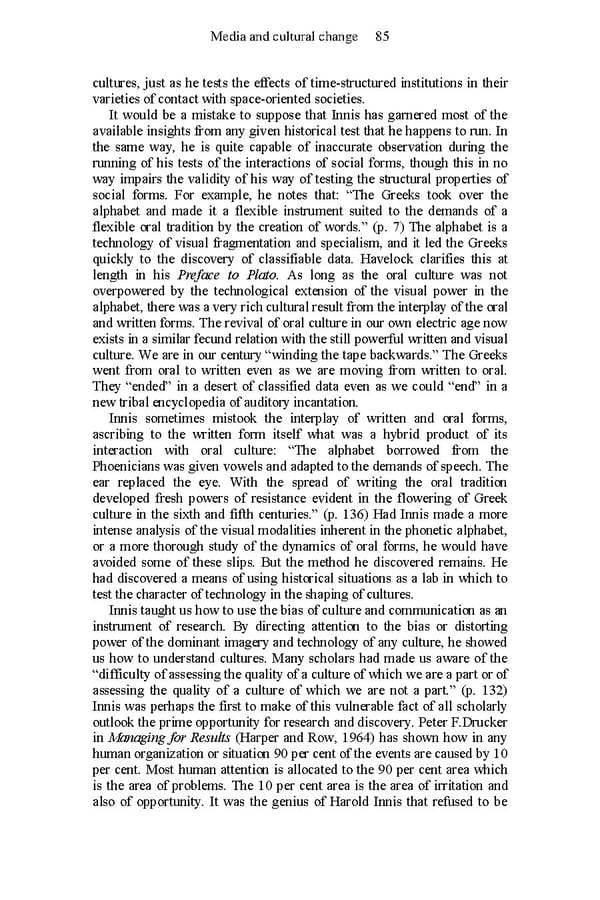Media and cultural change 85 cultures, just as he tests the effects of time-structured institutions in their varieties of contact with space-oriented societies. It would be a mistake to suppose that Innis has garnered most of the available insights from any given historical test that he happens to run. In the same way, he is quite capable of inaccurate observation during the running of his tests of the interactions of social forms, though this in no way impairs the validity of his way of testing the structural properties of social forms. For example, he notes that: “The Greeks took over the alphabet and made it a flexible instrument suited to the demands of a flexible oral tradition by the creation of words.” (p. 7) The alphabet is a technology of visual fragmentation and specialism, and it led the Greeks quickly to the discovery of classifiable data. Havelock clarifies this at length in his Preface to Plato. As long as the oral culture was not overpowered by the technological extension of the visual power in the alphabet, there was a very rich cultural result from the interplay of the oral and written forms. The revival of oral culture in our own electric age now exists in a similar fecund relation with the still powerful written and visual culture. We are in our century “winding the tape backwards.” The Greeks went from oral to written even as we are moving from written to oral. They “ended” in a desert of classified data even as we could “end” in a new tribal encyclopedia of auditory incantation. Innis sometimes mistook the interplay of written and oral forms, ascribing to the written form itself what was a hybrid product of its interaction with oral culture: “The alphabet borrowed from the Phoenicians was given vowels and adapted to the demands of speech. The ear replaced the eye. With the spread of writing the oral tradition developed fresh powers of resistance evident in the flowering of Greek culture in the sixth and fifth centuries.” (p. 136) Had Innis made a more intense analysis of the visual modalities inherent in the phonetic alphabet, or a more thorough study of the dynamics of oral forms, he would have avoided some of these slips. But the method he discovered remains. He had discovered a means of using historical situations as a lab in which to test the character of technology in the shaping of cultures. Innis taught us how to use the bias of culture and communication as an instrument of research. By directing attention to the bias or distorting power of the dominant imagery and technology of any culture, he showed us how to understand cultures. Many scholars had made us aware of the “difficulty of assessing the quality of a culture of which we are a part or of assessing the quality of a culture of which we are not a part.” (p. 132) Innis was perhaps the first to make of this vulnerable fact of all scholarly outlook the prime opportunity for research and discovery. Peter F.Drucker in Managing for Results (Harper and Row, 1964) has shown how in any human organization or situation 90 per cent of the events are caused by 10 per cent. Most human attention is allocated to the 90 per cent area which is the area of problems. The 10 per cent area is the area of irritation and also of opportunity. It was the genius of Harold Innis that refused to be
 Essential McLuhan Page 91 Page 93
Essential McLuhan Page 91 Page 93